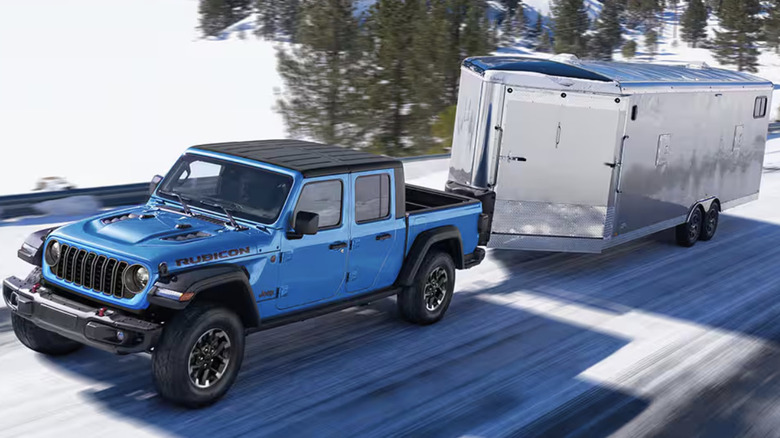Jeep Gladiator Mojave Vs. Rubicon: Differences Explained
The Jeep Gladiator has earned its reputation as a top off-roader. It's available in up to seven trim levels that cater to a wide range of adventurers, from the base Sport to the top-tier Mojave X. Within this lineup, the Rubicon and the Mojave trims are often top picks of many off-road enthusiasts, thanks to their incredibly powerful 3.6-liter V6 engine and terrain-specific performance. The Gladiator Mojave, Jeep's first model to earn the "Desert Rated" badge, is best suited for high-speed desert driving. It tackles sandy dunes and excels in wide-open landscapes. The Rubicon, on the other hand, bears the "Trail Rated" badge and is widely known for its rock-climbing abilities.
While the Mojave and the Rubicon share the Gladiator's off-road DNA — such as the 3.6-liter V6 engine, 8.4-inch touchscreen display, and 4,500-pound tow rating — these two off-roaders are slightly different based on where you want to drive them. Desert dunes of Jockey's Ridge State Park or rocky trails of the Rocky Mountain National Park? To cater to distinct purposes, it's important to know how the Mojave and Rubicon differ in suspension, drivetrain, and specialized features.
Suspension and off-road capabilites
Optimized for high-speed desert driving, the Gladiator Mojave features a part-time Command-Trac NV241 transfer case with a 2.72:1 low-range ratio. This gives it higher wheel speed capabilities of up to 50 mph in the low range, making it ideal for dune running. The Rubicon was designed for climbing rocks and tackling obstacle courses, it comes with a Rock-Trac NV241OR transfer case with a 4:1 low-range ratio, which is part of what makes Jeeps great climbers. In dune-running situations, the Gladiator Mojave can achieve substantially higher low-range wheel speeds than the Rubicon.
To top that off, the Mojave maintains an admirable crawl ratio of 52.6:1 with the 850RE eight-speed automatic and a 57.3:1 ratio with the AL6 six-speed manual. However, the Rubicon achieves a 77.2:1 crawl ratio with the auto and a best-in-class 84.2:1 ratio with the manual. It also features Fox 2.0-inch monotube shocks and Rubicon-specific tuned springs. Known for its best suspension system, the Mojave takes things slightly higher, featuring Fox 2.5-inch internal bypass shocks with hydraulic jounce bumpers and a 1-inch front suspension lift for additional ground clearance when handling sandy terrain.
The Mojave model has a bolstered frame, rear-locking differential, and strengthened upper control arms, while the Rubicon has an electronic front sway bar disconnect that increases suspension articulation by 30% and a front-locking differential that comes in handy when driving through rocky off-road trails.
Exterior and interior features
Along with a shared 285-horsepower V6, also offered on the 2024 Jeep Wrangler, the Mojave and Rubicon share the rugged utilitarian design of the Gladiator family. However, they have unique accents and functional features that set them apart. As mentioned, the Mojave features an exclusive Desert Rated Badge with orange accents that spread throughout the design, down to the tow hooks. The Rubicon's Trail Rated Badge is hard to miss, especially with the signature red accents, with matching tow hooks.
While both SUVs ride on 33-inch all-terrain tires, the Rubicon throws in steel off-road rock rails and a steel rear bumper for added protection during rock crawling. Similarly, the Mojave offers standard Steel "Sand Slider" rocker guards for dune-running protection. As a desert ride, it also comes with a Max Tow cooling package to improve the V6's performance in hot climates.
The Gladiator Mojave and Rubicon feature similar interior technology, such as the 8.4-inch touchscreen display with Uconnect® 4C NAV, Apple CarPlay, and Android Auto. The main interior differences between the two lie in the colors and accents. While the Rubicon has red stitching across the cabin, the Mojave interior sports matching orange stitching. As a sportier version of the two, the Gladiator Mojave has sport bolsters in the seats and racing grips on the steering wheel.


